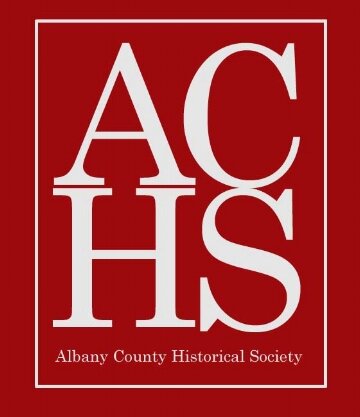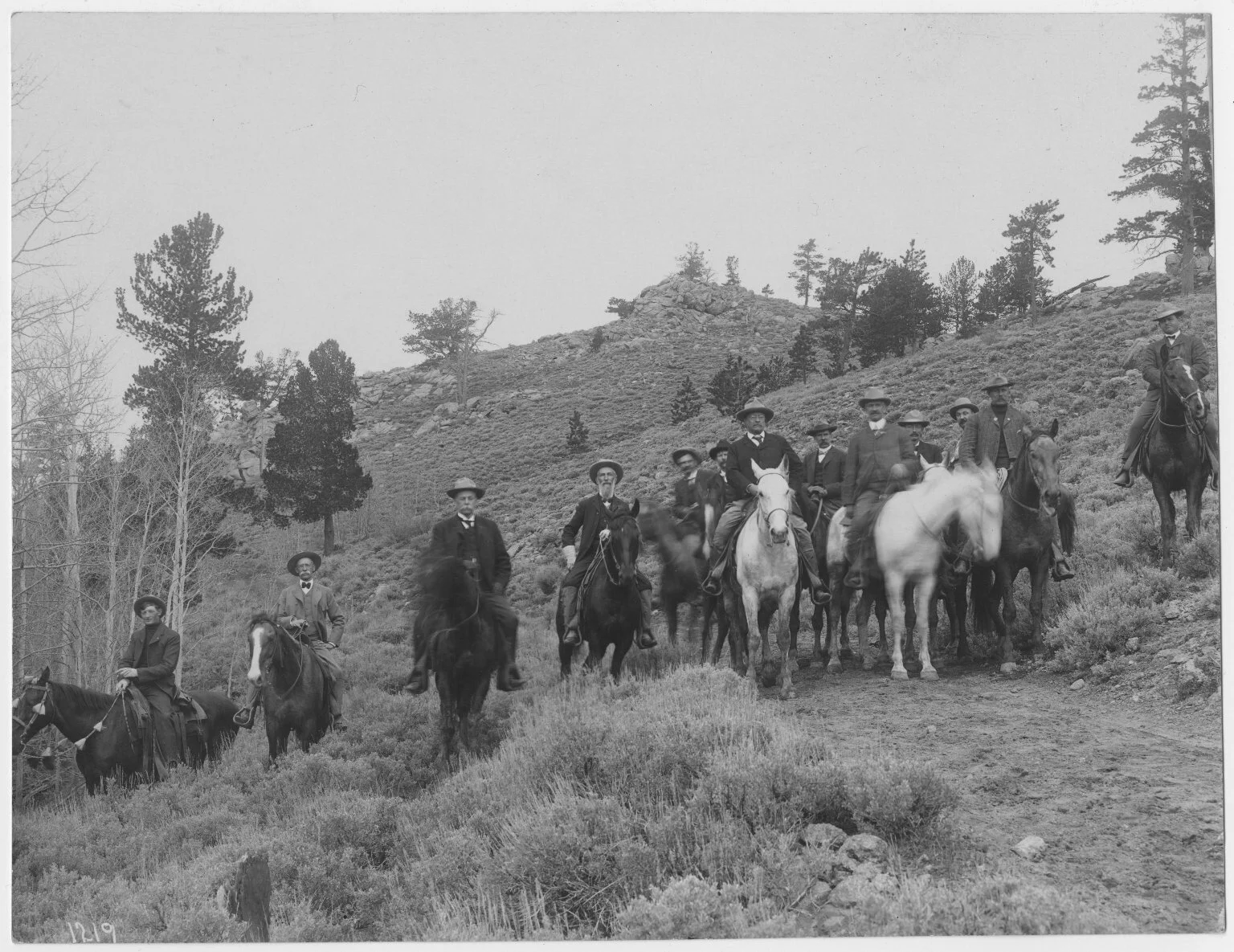Burt C. Buffum: early UW agriculturalist and avid photographer
From 1891 – 1907, Burt C. Buffum was a popular member of the town and gown community in Laramie. As a faculty member at the University, he made significant progress toward the development of Wyoming agriculture. Among his many contributions to the state and county, perhaps the most enduring legacy is his large collection of photographic negatives—an exceptional resource for regional historians.
Born in Indiana in 1868, Buffum was raised west of Fort Collins, Colorado, on his father’s sheep ranch. Upon graduating in 1889 from the Colorado Agriculture College (now CSU), he stayed to teach in its agriculture program. In 1891, just four years after the first UW students were admitted, the University of Wyoming hired him to teach meteorology, horticulture, and irrigation in its agriculture department.
Buffum arrived with his wife in March 1891, and within a month he was designated as the supervisor of the newly-created Wyoming Agricultural Experimental Station (WAES) at Laramie. He would continue in that role, under a variety of titles, for sixteen years, except for a two-year period from 1900 – 1902 when he was lured back to his alma mater in Ft. Collins.
Agricultural scientist
Upon arrival in Laramie, Buffum got right to work, keeping extensive meteorology records and surveying wild grasses west of Laramie. This survey would become a major project for the next two years, involving a thousand-mile collecting trip to northern Wyoming in the summer of 1892 and then the creation of a major exhibit for the Chicago World’s Columbian Exposition in 1893. His collection would become the foundation for his close colleague Aven Nelson’s famous Rocky Mountain Herbarium.
Over the next sixteen years under Buffum’s direction, the experiment station staff—assorted professors, assistants, and foremen—launched dozens of experiments to test the efficacy of soil additives, irrigation, and assorted breeds of plants and animals. Buffum understood Laramie’s climate and focused much of his energy on improving efforts to farm in arid conditions at high altitudes. His studies of alkali—that white stuff that occurs around all the lakes near Laramie—were of special significance for local farmers and ranchers.
Educator
Communicating the results of its scientific work to farmers and ranchers was paramount in the mission of the experiment station. Before 1904, communication was conducted almost entirely through the mail. The amount of Buffum’s personal correspondence was immense, evidenced by the number of his letterpress copybooks that are now preserved at the UW American Heritage Center (AHC).
In addition, the experiment station was expected to publish four bulletins per year. Buffum wrote at least one bulletin a year for a total of 23 by 1907, and he also wrote large sections of the annual reports. He established a policy that bulletins should be written for a general audience, reserving the annual reports for the presentation of data in tables and graphs.
WAES bulletins were distributed through the mail, free for the asking. Always a man looking for ways to maximize results of his work, in 1893 Buffum presented his irrigation bulletin to the Colorado Agriculture College in lieu of a thesis and received a master’s degree in 1893.
When he resigned from UW in 1900 to return to CSU as the director of its experiment station, Buffum founded and produced seven issues of a bimonthly magazine titled “Agricola Aridus,” which he edited with a distinct flair for the general audience. Upon returning to UW in 1903, as the bona fide director of the Wyoming Agricultural Experiment Station, he founded a magazine titled the “Ranchman’s Reminder,” again provided free of charge. This magazine became another way to circulate results of experiment station work.
After more than a decade of relying on the mail for communicating with farmers and ranchers, Buffum fulfilled his ambition of sponsoring a series of in-person short courses and farmers’ institutes. The first short course, consisting of 36 lectures on irrigation and stock judging over the course of 12 days, was offered in Laramie in 1904. It attracted an audience of 150 students and ranchmen. Occasional short courses continued to be offered that included demonstrations of slaughtering as well as lectures.
Through legislative funding, Buffum was then able to create two-day farmers’ institutes at low cost to the hosting cities. These became popular events. In 1906, close to 20 cities hosted two-day institutes that featured talks by Buffum and other experiment station faculty.
From 1891 on when Buffum established his first lab for developing glass plate photographic negatives, Buffum further documented his experiment station work. He took thousands of photos of agriculture products grown in Laramie and at other substations throughout the state, and he featured these photographs in numerous bulletins and articles. He became widely known in the state for his illustrated lectures using the stereopticon, also known as lantern slides.
Family pursuits
Buffum married Maude Southworth in 1890. When they moved a year later to Laramie, they both became popular and influential members of the community. Maude was a founding member of the Laramie Woman’s Club in 1898, frequently agreeing to be a discussion leader or main speaker at its meetings. She took a turn as vice president and then president in 1903.
She was also a reader for the Christian Science community meetings.
When the Buffum’s three-year old son Cecil died of diphtheria in 1897, UW canceled all classes to allow attendance at his funeral. Their daughter Eduma, born in 1895, became by age twelve an accomplished piano student of Professor Mary Slavens Clark. Three more children were born to the couple from 1901 – 1910.
The Buffums somehow found time for an active recreational life. The family enjoyed many camping trips west to the Medicine Bows, documented, of course, by Burt’s camera. Burt was an accomplished fisherman and duck hunter, participating in numerous local river and lake trips with fellow outdoorsmen.
Burt and Maude joined the Laramie bicycle club when they arrived in 1891. The Boomerang reported several trips he took by bicycle to Fort Collins and Cheyenne, and he appears in some of the group bicycle photographs in the Elmer Lovejoy collection at the AHC. In 1900, he and Maude adopted golfing as a sport, and Burt soon became one of the top male golfers in the city. The golf course, called Laramie Golf Links, was laid out on the east UW grounds, the survey for which was prepared by Buffum’s experiment station assistant, A.C. Danielson.
Arborist
In 1891, the Laramie experiment station had two sites, one consisting of 120 acres of land along the Pioneer Canal west of Laramie, and the other consisting of the land directly south of the university’s Language Hall (now Old Main). A greenhouse and two small barns occupied this space on the campus. It is not surprising that Buffum, who worked in the greenhouse, would become interested in landscaping both the University and city grounds.
An early landscape project for him was to beautify the bare prairie land west of Language Hall with a variety of plantings, including trees. From then on, he would sponsor regular tree plantings throughout Laramie, especially on Arbor Day. For the 1897 Arbor Day, he managed the planting of 150 trees, only a third of which survived.
He wrote a copiously illustrated bulletin titled “Cultivated Shade and Forest Trees” that featured some of Laramie’s trees. One year, he had to deliver the bad news to his fellow Laramie citizens that there was no cure for the crown gall that was killing their beloved cottonwood trees. Buffum’s focus on tree planting certainly helped Laramie transform itself from a treeless spot on the vast prairie to one of the noteworthy “Tree Cities” in Wyoming.
Promoting agriculture
Ever the enthusiastic spokesman for agriculture, from early in his career Buffum jumped at the chance to feature Wyoming products at expositions and fairs. His first foray into exposition work was to prepare an exhibit of the grasses he had collected in the summer of 1892 for the 1893 Chicago exposition. Agreeing to be manager for the entire Wyoming collection of exhibits, he took a six-month leave of absence from university work to live in Chicago, where he and Maude rode their bikes every day to the exhibition site to act as hosts for the Wyoming exhibits.
A decade later, he prepared and shipped Wyoming exhibits for expositions in St. Louis, Portland, Salt Lake City, Ogden, and Chillicothe, Missouri. These exhibits won numerous gold medals and garnered much praise. Locally, he fulfilled committee assignments for the Albany County Fair, and he always volunteered to judge exhibits at the county and state levels.
An entertaining speaker, Buffum was frequently asked to speak about his agricultural work at university and city club meetings. As a result of his city connections, Buffum became increasingly interested in supporting the commercial development of Laramie and Albany County. He was a trustee of the Board of Trade, and he also joined the Commercial Club, a precursor to the Chamber of Commerce. He agreed to help this club produce two pamphlets on Albany County mining and agriculture as a promotional venture, for which he provided photographs of the Douglas mining district and county farm products.
Photographic legacy
The photographs Buffum took for experiment station work around the state firmly established the camera as an essential tool for documenting scientific work. He also took hundreds of photographs of university and city buildings, student and faculty groups, and Laramie streets. He was president of the university camera club, whose membership included both students and faculty.
Perhaps the most famous photograph in his collection is the 1903 image he captured of Teddy Roosevelt and Laramie citizens on horseback as they emerged from Telephone Canyon on their way to Cheyenne. Another famous set of images depicts the bucking horse named Steamboat being ridden by Guy Holt at the 1903 Albany County Fair, which some have argued is a model for the UW bucking bronco icon.
In 1907, Buffum left his career as a university faculty member for an altogether different life in Worland, where he established a commercially-successful seed breeding company with the help of Laramie investor Otto Gramm. He eventually moved to Denver and died at age 76 in 1944.
But his legacy also remains in Laramie. Altogether, the more than 3000 glass plate negatives and lantern slides in the B.C. Buffum collection at the AHC, which includes the work of fellow photographers as well as his own. They provide extraordinary photographic documentation of life in Albany County at the turn of the century.
By Jane Nelson
The Buffum family at home at 406 South 9th St. in Laramie: Maude, Eduma, and Burt in 1899. Photographer unknown.
University greenhouses on the University of Wyoming grounds southeast of Language Hall (now Old Main). Note the bicycle parked against the building. Photo taken by B.C. Buffum, 1899.
Teddy Roosevelt and others emerging from Telephone Canyon on their ride from Laramie to Cheyenne, Wyoming. Photo by B.C. Buffum, May 30, 1903.


